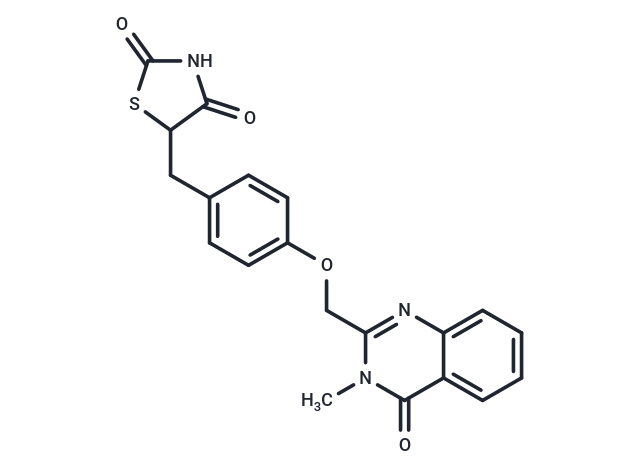Shopping Cart
- Remove All
 Your shopping cart is currently empty
Your shopping cart is currently empty

Balaglitazone is a selective peroxisome proliferator-activated receptor (PPARγ) partial agonist with an EC50 value of 1.351 μM for human PPARγ.Balaglitazone can be used as a supplement to insulin therapy, regulates blood glucose, and can be used in studies of heart failure and myocardial infarction.

| Pack Size | Price | Availability | Quantity |
|---|---|---|---|
| 1 mg | $83 | In Stock |
| Description | Balaglitazone is a selective peroxisome proliferator-activated receptor (PPARγ) partial agonist with an EC50 value of 1.351 μM for human PPARγ.Balaglitazone can be used as a supplement to insulin therapy, regulates blood glucose, and can be used in studies of heart failure and myocardial infarction. |
| Targets&IC50 | PPARγ (human):351 μM (EC50) |
| In vitro | Balaglitazone exhibits equal cytotoxicity in K562 and K562/DOX cells, with IC50 values of 0.117 μM and 0.53 μM, respectively, and reduces the cytotoxicity of doxorubicin in these cells[2]. |
| In vivo | In male diet-induced obese rats, oral administration of Balaglitazone at 10 mg/kg suppresses overall blood glucose, reduces insulin levels, and increases body weight, with effects equivalent to 30 mg/kg pioglitazone[3]. |
| Cell Research | MTT assay is used for cell viability analyses. Briefly, K562 and K562/DOX cells are seeded in a 96-well plate in RPMI-1640 medium supplemented with 10% FBS at the density of 2 × 104 cells/well. After 24 h incubation, various concentrations of doxorubicin (DOX) with or without balaglitazone are diluted in RPMI-1640 medium (without FBS) and added into each well. Experiments for each group are performed in triplicates and with a blank control. After 48 h of treatment, the medium is removed and 200 μL of RPMI-1640 medium supplemented with 10% FBS and 10% MTT (5 mg/mL) is added. After incubation for another 4 h, the reduced intracellular formazan product is dissolved by replacing 100 μL of RPMI-1640 medium with the same volume of dimethyl sulfoxide (DMSO). Absorbance values are measured at 570 nm with a microplate reader. The half-maximal inhibitory concentration (IC50) of each experiment is calculated. The resistance fold (RF) is calculated by dividing the IC50 value of treatment in resistant cells by the IC50 value of treatment in corresponding parental cells [2]. |
| Animal Research | Antihyperglycaemic effects of balaglitazone and rosiglitazone are assessed in adult male diabetic db/db mice. At 14 weeks of age, animals are randomized according to fasting blood glucose into 11 groups (n = 6). Mice are dosed orally once daily for 9 days with vehicle (0.2% carboxymethyl cellulose (CMC) + 0.4% Tween-80 in saline) or increasing doses of either balaglitazone (0.1; 0.3; 1.0; 3.0; 10.0 mg/kg/day) or rosiglitazone (0.2; 0.6; 2.0; 6.0 mg/kg/day). After 7 days of treatment, plasma samples obtained in the morning (between 8:00 and 10:00 AM) are analyzed for glucose and insulin. After 9 days of treatment, animals are exposed to an oral glucose tolerance test (OGTT; 3.0 g/kg). The resulting area under the curve is calculated for each of the doses [1]. |
| Alias | NN-2344, NN2344, NN 2344, DRF-2593, DRF2593, DRF 2593 |
| Molecular Weight | 395.43 |
| Formula | C20H17N3O4S |
| Cas No. | 199113-98-9 |
| Smiles | Cn1c(COc2ccc(CC3SC(=O)NC3=O)cc2)nc2ccccc2c1=O |
| Relative Density. | 1.45 g/cm3 (Predicted) |
| Storage | store at low temperature | Powder: -20°C for 3 years | In solvent: -80°C for 1 year | Shipping with blue ice. | |||||||||||||||||||||||||||||||||||
| Solubility Information | DMSO: 80 mg/mL (202.31 mM), Sonication is recommended. | |||||||||||||||||||||||||||||||||||
Solution Preparation Table | ||||||||||||||||||||||||||||||||||||
DMSO
| ||||||||||||||||||||||||||||||||||||

Copyright © 2015-2025 TargetMol Chemicals Inc. All Rights Reserved.